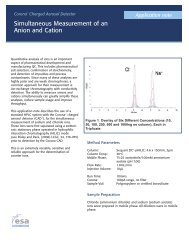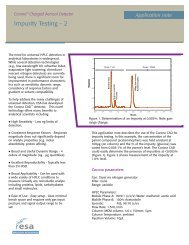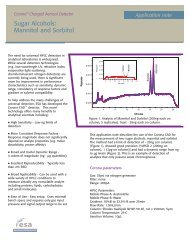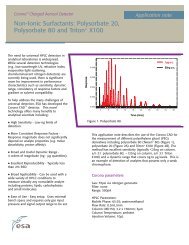Total Glycerides of Biodiesel by Normal Phase HPLC and Corona ultra
Total Glycerides of Biodiesel by Normal Phase HPLC and Corona ultra
Total Glycerides of Biodiesel by Normal Phase HPLC and Corona ultra
- No tags were found...
Create successful ePaper yourself
Turn your PDF publications into a flip-book with our unique Google optimized e-Paper software.
<strong>Corona</strong> <strong>ultra</strong> Charged Aerosol DetectorApplication noteAnalyte LOQ (ng) LOQ (w/w-%) LOD (ng) LOD (w/w-%)Triolein 15 0.002 5 0.00061,3-Diolein 15 0.002 5 0.00061-Oleylglycerol 15 0.002 5 0.0007Glycerol 50 0.006 20 0.002Table 1. LOQ <strong>and</strong> LOD values for different analytes.Method ParametersColumn: *SGE Exsil CN 250 x 4.0 mm, 5 µm, 35°CNebulizer Heater: 30°CFilter:NoneMobile <strong>Phase</strong> A: iso-Octane/HOAc (1000:4)Mobile <strong>Phase</strong> B: iso-Octane/2-Propanol/HOAc (1000:1:4)Mobile <strong>Phase</strong> C: Methyl-t-butyl ether/HOAc (1000:4)Mobile <strong>Phase</strong> D: iso-Octane/n-Butyl acetate/Methanol/HOAc (500:167:333:4)Gradient Pr<strong>of</strong>ile: Table 2Flow Rate: 1.0-1.2 mL/minRun Time: 40 minutesInjection Volume: 10µL at 10°CSample Conc: 100µL <strong>Biodiesel</strong> in 900µL iso-Octane/2-Propanol (98:2)Due to the complex nature <strong>of</strong> the sample matrix, agradient program was created, using four mobile phases:mobile phase A allows for the sample to be loadedwithout splitting the more polar analytes; mobile phase Bprovides additional selectivity over mobile phase A with2-propanol concentrations between 0.1–0.2%; mobilephase C elutes the polar compounds; <strong>and</strong> mobile phaseD elutes the glycerol. Mobile phase C is used again torinse the column <strong>of</strong> any remaining D, <strong>and</strong> then thecolumn is re-conditioned.St<strong>and</strong>ardizationStock st<strong>and</strong>ard solutions were prepared in iso-octane,with glycerol dissolved in 2-propanol, at concentrations<strong>of</strong> 1 mg/mL each. The stock solutions were then dilutedtogether creating a mixed st<strong>and</strong>ard solution <strong>of</strong>approximately 20µg/mL each. The dilution solvent wasiso-octane/2-propanol (98:2). Sequential dilutions weremade with a dilution factor <strong>of</strong> 2. Ten microliters <strong>of</strong> eachst<strong>and</strong>ard solution was injected in triplicate, yielding thecurves shown in Figure 2. Note the uniformity <strong>of</strong>response across the three acylated glycerol st<strong>and</strong>ards.Curve fitting was performed using an “InvertedQuadratic” fit for the alkylated glycerols <strong>and</strong> a quadraticfit for glycerol.Time %A %B %C %D Flow Rate0.00 100 0 0 0 1.05.00 0 98.0 2.0 0 1.07.00 0 95.0 5.0 0 1.015.00 0 92.0 8.0 0 1.017.00 0 65.0 35.0 0 1.023.00 0 50.0 50.0 0 1.023.10 80 0 0 20.0 1.025.00 10 0 0 90.0 1.028.00 10 0 0 90.0 1.028.1 20 0 80.0 0 1.029.00 20 0 80.0 0 1.029.50 100 0 0 0 1.239.00 100 0 0 0 1.239.50 100 0 0 0 1.0Table 2. Gradient conditions.Figure 3. Full-range st<strong>and</strong>ardization curve forTriolein (violet), 1,3-Diolein (green), 1-Oleylglycerol(red), <strong>and</strong> Glycerol (blue).
















